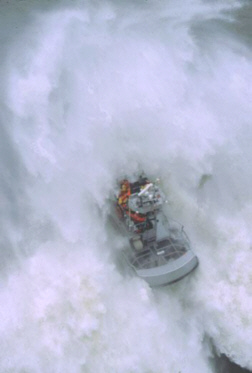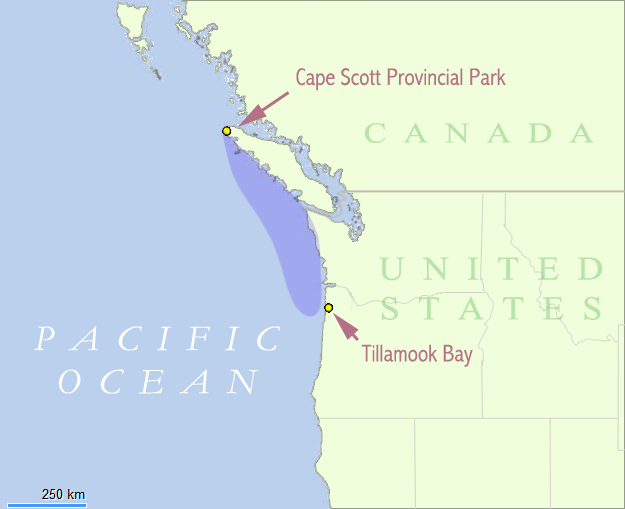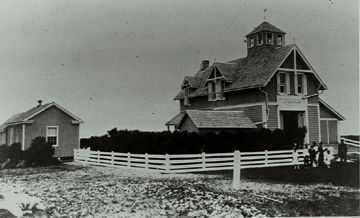|
Coast Guard Station Cape Disappointment
United States Coast Guard Station Cape Disappointment, situated near Cape Disappointment, Washington, at the mouth of the Columbia River, is the largest United States Coast Guard search and rescue station on the Northwest Coast, with 50 crewmembers assigned. Cape Disappointment Station is also the site of the oldest search and rescue station within the Thirteenth Coast Guard District. The station's Area of Responsibility reaches from Ocean Park on the Washington Coast south to Tillamook Head on the Oregon Coast. Official web page National Motor Lifeboat School, US Coast Guard official website. [...More Info...] [...Related Items...] OR: [Wikipedia] [Google] [Baidu] |
Cape Disappointment (Washington)
Cape Disappointment is a headland of the Pacific Northwest, located at the extreme southwestern corner of Washington, United States, on the north side of the Columbia River bar and just west of Baker Bay. The point of the cape is located on the Pacific Ocean in Washington's Pacific County, approximately two miles (3.2 km) southwest of the town of Ilwaco. Cape Disappointment sees about 2,552 hours of fog a year—the equivalent of 106 days—making it one of the foggiest places in the U.S. The cape was named on July 6, 1788, by British fur trader John Meares, who was sailing south from Nootka Island, Canada, in search of trade. He mistook the mouth of the Columbia River for a bay, which the ship could not enter due to a shallow shoal. Just missing the discovery of the river mentioned by Francisco Antonio Mourelle, he named them Cape Disappointment and Deception Bay. George Vancouver credits John Meares in his account when he saw Cape Disappointment on April 27, 1792.Vancouve ... [...More Info...] [...Related Items...] OR: [Wikipedia] [Google] [Baidu] |
Graveyard Of The Pacific
The Graveyard of the Pacific is a somewhat loosely defined stretch of the Pacific Northwest coast stretching from around Tillamook Bay on the Oregon Coast northward past the treacherous Columbia Bar and Juan de Fuca Strait, up the rocky western coast of Vancouver Island to Cape Scott. Unpredictable weather conditions, including storms and fog, and dangerous coastal characteristics, including shifting sandbars, tidal rips, and rocky reefs and shorelines, have caused thousands of ships to wreck in the area since European exploration of the area began in earnest in the 18th century. More than 2,000 ships have wrecked in the area, with more than 700 lives lost, near the Columbia Bar alone. One book lists 484 wrecks at the south and west sides of Vancouver Island. Although major wrecks have declined since the 1920s, several lives are still lost annually. Among its particularly dangerous landmarks are the Columbia Bar, a giant sandbar at the mouth of the Columbia River; Cape Fla ... [...More Info...] [...Related Items...] OR: [Wikipedia] [Google] [Baidu] |
Military Installations In Washington (state)
A military, also known collectively as armed forces, is a heavily armed, highly organized force primarily intended for warfare. It is typically authorized and maintained by a sovereign state, with its members identifiable by their distinct military uniform. It may consist of one or more military branches such as an army, navy, air force, space force, marines, or coast guard. The main task of the military is usually defined as defence of the state and its interests against external armed threats. In broad usage, the terms ''armed forces'' and ''military'' are often treated as synonymous, although in technical usage a distinction is sometimes made in which a country's armed forces may include both its military and other paramilitary forces. There are various forms of irregular military forces, not belonging to a recognized state; though they share many attributes with regular military forces, they are less often referred to as simply ''military''. A nation's military may f ... [...More Info...] [...Related Items...] OR: [Wikipedia] [Google] [Baidu] |
United States Coast Guard Stations
This article contains a list of United States Coast Guard stations in the United States within the United States Coast Guard's nine districts. There are currently many stations located throughout the country along the shores of the Atlantic Ocean, Gulf of Mexico, Pacific Ocean and Great Lakes. Although many of the stations have been located on shore, floating stations have been based on the Ohio River and Dorchester Bay. Many of the stations listed date from the 1800s, during the existence of the United States Life-Saving Service. Development of stations were started with the 1848 signing of the Newell Act. This act allowed Congress to appropriate $10,000 to established unmanned life-saving stations along the New Jersey coast south of New York Harbor and to provide "surf boat, rockets, carronades and other necessary apparatus for the better preservation of life and property from shipwreck ... ." During that same year, the Massachusetts Humane Society received funds from Congr ... [...More Info...] [...Related Items...] OR: [Wikipedia] [Google] [Baidu] |
National Motor Lifeboat School
National may refer to: Common uses * Nation or country ** Nationality – a ''national'' is a person who is subject to a nation, regardless of whether the person has full rights as a citizen Places in the United States * National, Maryland, census-designated place * National, Nevada, ghost town * National, Utah, ghost town * National, West Virginia, unincorporated community Commerce * National (brand), a brand name of electronic goods from Panasonic * National Benzole (or simply known as National), former petrol station chain in the UK, merged with BP * National Car Rental, an American rental car company * National Energy Systems, a former name of Eco Marine Power * National Entertainment Commission, a former name of the Media Rating Council * National Motor Vehicle Company, Indianapolis, Indiana, USA 1900-1924 * National Supermarkets, a defunct American grocery store chain * National String Instrument Corporation, a guitar company formed to manufacture the first resonator gui ... [...More Info...] [...Related Items...] OR: [Wikipedia] [Google] [Baidu] |
United States Revenue Cutter Service
) , colors= , colors_label= , march= , mascot= , equipment= , equipment_label= , battles= , anniversaries=4 August , decorations= , battle_honours= , battle_honours_label= , disbanded=28 January 1915 , flying_hours= , website= , commander1= , commander1_label= , commander2= , commander2_label= , commander3= , commander3_label= , commander4= , commander4_label= , notable_commanders= , identification_symbol= , identification_symbol_label=Ensign (1799) , identification_symbol_2= , identification_symbol_2_label=Ensign (1815) , identification_symbol_3= , identification_symbol_3_label=Ensign (1836) , identification_symbol_4= , identification_symbol_4_label=Ensign (1841) , identification_symbol_5= , identification_symbol_5_label=Ensign (1867) , identification_symbol_6= , identification_symbol_6_label=Ensign (1868) The United States Revenue Cutter Service was established by an act of Congress () on 4 August 1790 as the Revenue-Marine upon the recommendation of Secretary of the Treasury ... [...More Info...] [...Related Items...] OR: [Wikipedia] [Google] [Baidu] |
Fort Canby (Washington)
Cape Disappointment State Park (formerly Fort Canby State Park) is a public recreation area on Cape Disappointment, located southwest of Ilwaco, Washington, on the bottom end of Long Beach Peninsula, the northern headlands where the Columbia River meets the Pacific Ocean. The state park's encompass a diverse landscape of old-growth forest, freshwater lakes, freshwater and saltwater marshes, and oceanside tidelands. Park sites include Fort Canby, the Lewis and Clark Interpretive Center, North Head Lighthouse, and Cape Disappointment Lighthouse. Cape Disappointment is one of several state parks and sites in Washington and Oregon that are included in Lewis and Clark National Historical Park. History Cape Disappointment earned its name when Captain John Meares failed to cross the river bar in 1788. The feat was accomplished in 1792 by American Captain Robert Gray. The Lewis and Clark Expedition arrived at Cape Disappointment in 1805. In 1862, during the American Civil War, a camp ... [...More Info...] [...Related Items...] OR: [Wikipedia] [Google] [Baidu] |
United States Life-Saving Service
The United States Life-Saving ServiceDespite the lack of hyphen in its insignia, the agency itself is hyphenated in government documents including: and was a United States government agency that grew out of private and local humanitarian efforts to save the lives of shipwrecked mariners and passengers. It began in 1848 and ultimately merged with the Revenue Cutter Service to form the United States Coast Guard in 1915. Early years The concept of assistance to shipwrecked mariners from shore-based stations began with volunteer lifesaving services, spearheaded by the Massachusetts Humane Society. It was recognized that only small boats stood a chance of assisting those close to the beach. A sailing ship trying to help near to the shore stood a good chance of also running aground, especially if there were heavy onshore winds. The Massachusetts Humane Society founded the first lifeboat station at Cohasset, Massachusetts. The stations were small shed-like structures, holding rescue e ... [...More Info...] [...Related Items...] OR: [Wikipedia] [Google] [Baidu] |
Chinookan
The Chinookan languages were a small family of languages spoken in Oregon and Washington (state), Washington along the Columbia River by Chinook peoples. Although the last known native speaker of any Chinookan language died in 2012, the 2009-2013 American Community Survey found 270 self-identified speakers of Upper Chinook language, Upper Chinook. Family division Chinookan consisted of three languages with multiple Variety (linguistics), varieties. There is some dispute over classification, and there are two ISO 639-3 codes assignedchh(Chinook, Lower Chinook) anwac(Wasco-Wishram, Upper Chinook). For example, Ethnologue 15e classifies Kiksht as Lower Chinook, while others consider it instead Upper Chinookdiscussion, and others a separate language. * Lower Chinook (also known as Chinook-proper or Coastal Chinook) † * Kathlamet language, Kathlamet (also known as Katlamat, Cathlamet) † * Upper Chinook language, Upper Chinook (also known as Kiksht, Columbia Chinook) † Phonology ... [...More Info...] [...Related Items...] OR: [Wikipedia] [Google] [Baidu] |
Columbia Rediviva
''Columbia Rediviva'' (commonly known as ''Columbia'') was a privately owned American ship under the command, first, of John Kendrick, and later Captain Robert Gray, best known for going to the Pacific Northwest for the maritime fur trade. "Rediviva" (''Latin'' "revived") was added to her name upon a rebuilding in 1787. Since ''Columbia'' was privately owned, she did not carry the prefix designation " USS". History Early authorities claim the ship was built in 1773 by James Briggs at Hobart's Landing on North River, in Norwell, Massachusetts and named ''Columbia''. Later historians say she was built in Plymouth, Massachusetts in 1787. In 1790 she became the first American ship to circumnavigate the globe. During the first part of this voyage, she was accompanied by ''Lady Washington'' which served as tender for ''Columbia''. In 1792 Captain Gray entered the Columbia River and named it after the ship. The river and its basin, in turn, lent its name to the surrounding r ... [...More Info...] [...Related Items...] OR: [Wikipedia] [Google] [Baidu] |
Robert Gray (sea Captain)
Robert Gray (May 10, 1755 – ) was an American Merchant Sea Captain who is known for his achievements in connection with two trading voyages to the northern Pacific coast of North America, between 1790 and 1793, which pioneered the American maritime fur trade in that region. In the course of those voyages, Gray explored portions of that coast and in the year 1790 he completed the first American circumnavigation of the world. He was also noted for coming upon and naming the Columbia River, in 1792, while on his second voyage. Gray's earlier and later life are both comparatively obscure. He was born in Tiverton, Rhode Island, and may have served in the Continental Navy during the American Revolutionary War. After his two famous voyages, he carried on his career as a sea captain, mainly of merchantmen in the Atlantic. He intended a third voyage to the Northwest Coast, but his ship was captured by French privateers, during the Franco-American Quasi-War. Later in that conflict, Gray ... [...More Info...] [...Related Items...] OR: [Wikipedia] [Google] [Baidu] |
Royal Navy
The Royal Navy (RN) is the United Kingdom's naval warfare force. Although warships were used by English and Scottish kings from the early medieval period, the first major maritime engagements were fought in the Hundred Years' War against France. The modern Royal Navy traces its origins to the early 16th century; the oldest of the UK's armed services, it is consequently known as the Senior Service. From the middle decades of the 17th century, and through the 18th century, the Royal Navy vied with the Dutch Navy and later with the French Navy for maritime supremacy. From the mid 18th century, it was the world's most powerful navy until the Second World War. The Royal Navy played a key part in establishing and defending the British Empire, and four Imperial fortress colonies and a string of imperial bases and coaling stations secured the Royal Navy's ability to assert naval superiority globally. Owing to this historical prominence, it is common, even among non-Britons, to ref ... [...More Info...] [...Related Items...] OR: [Wikipedia] [Google] [Baidu] |



.png)



